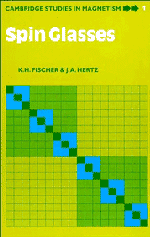Book contents
- Frontmatter
- Contents
- Preface
- 1 Introduction
- 2 Models, order parameters, and systems
- 3 Mean field theory I: Ising model, equilibrium theory
- 4 Introduction to dynamics
- 5 Mean field theory II: Ising dynamics
- 6 Mean field theory III: vector spins
- 7 Short-range interactions: low-temperature properties
- 8 Beyond mean field theory
- 9 Dynamics on many time scales
- 10 Specific heat, sound propagation, and transport properties
- 11 Competition between spin glass and ferromagnetic or antiferromagnetic order
- 12 One-dimensional models
- 13 Random field and random anisotropy
- 14 The physics of complexity
- 15 A short history of spin glasses
- References
- Index
8 - Beyond mean field theory
Published online by Cambridge University Press: 01 June 2011
- Frontmatter
- Contents
- Preface
- 1 Introduction
- 2 Models, order parameters, and systems
- 3 Mean field theory I: Ising model, equilibrium theory
- 4 Introduction to dynamics
- 5 Mean field theory II: Ising dynamics
- 6 Mean field theory III: vector spins
- 7 Short-range interactions: low-temperature properties
- 8 Beyond mean field theory
- 9 Dynamics on many time scales
- 10 Specific heat, sound propagation, and transport properties
- 11 Competition between spin glass and ferromagnetic or antiferromagnetic order
- 12 One-dimensional models
- 13 Random field and random anisotropy
- 14 The physics of complexity
- 15 A short history of spin glasses
- References
- Index
Summary
Renormalization in pure systems
In Section 2.2 we reviewed the basic facts about broken symmetry and phase transitions in pure systems, within mean field theory. This helped set the stage for the mean field description of spin glasses that we studied in Chapters 3–6. We will now want to study the phase transition and the nature of the low-temperature phase for spin glasses with fairly short-ranged interactions in low dimensionality (2 or 3). This situation is far from the region where mean field theory is a good guide, so we will have to learn new methods. Again, we start by learning about them in pure systems.
Renormalization is a very general approach to problems with many strongly interacting degrees of freedom. In a statistical mechanical problem, the basic idea is to carry out the trace in the partition function over some of the variables, leaving a new problem with fewer degrees of freedom. One follows how the parameters in the Hamiltonian of the system change as this procedure is iterated many times. Generally, the partial trace corresponds to removing the short-distance degrees of freedom, so each successive effective Hamiltonian has a larger lattice constant (or equivalent microscopic length) than its predecessor: each renormalization step corresponds to a change of scale. Different thermodynamic phases are identified with flows to different fixed points in the parameter space of the Hamiltonian under this semigroup.
- Type
- Chapter
- Information
- Spin Glasses , pp. 219 - 266Publisher: Cambridge University PressPrint publication year: 1991



